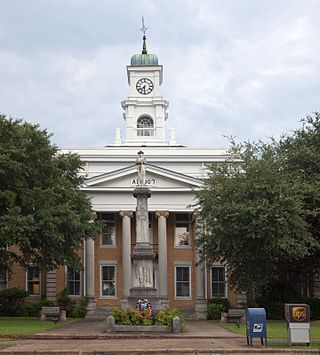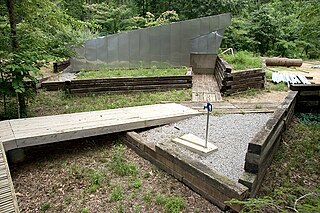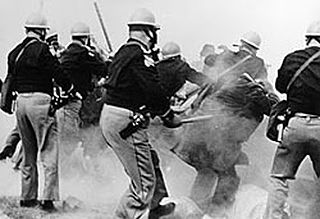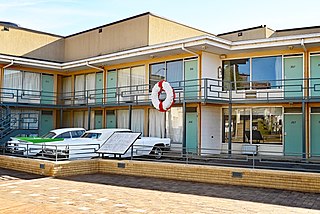
Martin Luther King Jr. was an American Christian minister, activist, and political philosopher who was one of the most prominent leaders in the civil rights movement from 1955 until his assassination in 1968. A Black church leader and a son of early civil rights activist and minister Martin Luther King Sr., King advanced civil rights for people of color in the United States through the use of nonviolent resistance and nonviolent civil disobedience against Jim Crow laws and other forms of legalized discrimination.

Hale County is a county located in the west central portion of the U.S. state of Alabama. As of the 2020 census, the population was 14,785. Its county seat is Greensboro. It is named in honor of Confederate officer Stephen Fowler Hale.

Greensboro is a city in and the county seat of Guilford County, North Carolina, United States. At the 2020 census, its population was 299,035; it was estimated to be 301,115 in 2022. It is the third-most populous city in North Carolina after Charlotte and Raleigh and the 69th-most populous city in the United States. The population of the Greensboro-High Point, NC Metropolitan Statistical Area was estimated to be 789,842 in 2023. The Piedmont Triad region, of which Greensboro is the most populous city, had an estimated population of 1,736,099 in 2023.

Greensboro is a city in Hale County, Alabama, United States. At the 2010 census the population was 2,497, down from 2,731 at the 2000 census. The city is the county seat of Hale County, Alabama, which was not organized until 1867. It is part of the Tuscaloosa, Alabama Metropolitan Statistical Area.

The Montgomery bus boycott was a political and social protest campaign against the policy of racial segregation on the public transit system of Montgomery, Alabama. It was a foundational event in the civil rights movement in the United States. The campaign lasted from December 5, 1955—the Monday after Rosa Parks, an African-American woman, was arrested for her refusal to surrender her seat to a white person—to December 20, 1956, when the federal ruling Browder v. Gayle took effect, and led to a United States Supreme Court decision that declared the Alabama and Montgomery laws that segregated buses were unconstitutional.

The Rural Studio is a design-build architecture studio run by Auburn University. It teaches students about the social responsibilities of the profession of architecture and provides good houses and buildings for poor communities in rural west Alabama, US, part of what is called the "Black Belt".

The Selma to Montgomery marches were three protest marches, held in 1965, along the 54-mile (87 km) highway from Selma, Alabama, to the state capital of Montgomery. The marches were organized by nonviolent activists to demonstrate the desire of African-American citizens to exercise their constitutional right to vote, in defiance of segregationist repression; they were part of a broader voting rights movement underway in Selma and throughout the American South. By highlighting racial injustice, they contributed to passage that year of the Voting Rights Act, a landmark federal achievement of the civil rights movement.

The National Civil Rights Museum is a complex of museums and historic buildings in Memphis, Tennessee; its exhibits trace the history of the civil rights movement in the United States from the 17th century to the present. The museum is built around the former Lorraine Motel, which was the site of the 1968 assassination of Martin Luther King Jr. Two other buildings and their adjacent property, also connected with the King assassination, have been acquired as part of the museum complex.

Martin Luther King III is an American human rights activist, philanthropist and advocate. The elder son of civil rights leaders Martin Luther King Jr. and Coretta Scott King, King served as the fourth president of the Southern Christian Leadership Conference from 1997 to 2004.

Dexter Avenue Baptist Church is a Baptist church in Montgomery, Alabama, United States, affiliated with the Progressive National Baptist Convention. The church was designated as a National Historic Landmark in 1974 because of its importance in the civil rights movement and American history. In 1978 the official name was changed to the Dexter Avenue King Memorial Baptist Church, in memory of Dr. Martin Luther King Jr., who was pastor there and helped organize the Montgomery bus boycott in 1955 during the civil rights era. The church is located steps away from the Alabama State Capitol.

Martin Luther King Jr., an African-American clergyman and civil rights movement leader, was fatally shot at the Lorraine Motel in Memphis, Tennessee, on April 4, 1968, at 6:01 p.m. CST. He was rushed to St. Joseph's Hospital, where he died at 7:05 p.m. He was a prominent leader of the civil rights movement and a Nobel Peace Prize laureate who was known for his use of nonviolence and civil disobedience.

The St. Augustine movement was a part of the wider Civil Rights Movement, taking place in St. Augustine, Florida from 1963 to 1964. It was a major event in the city's long history and had a role in the passage of the Civil Rights Act of 1964.

Randolph T. Blackwell was an American activist of the Civil Rights Movement, serving in Martin Luther King Jr.'s Southern Christian Leadership Conference, amongst other organizations. Coretta Scott King described him as an "unsung giant" of nonviolent social change.
The history of the 1954 to 1968 American civil rights movement has been depicted and documented in film, song, theater, television, and the visual arts. These presentations add to and maintain cultural awareness and understanding of the goals, tactics, and accomplishments of the people who organized and participated in this nonviolent movement.
This is a timeline of the civil rights movement in the United States, a nonviolent mid-20th century freedom movement to gain legal equality and the enforcement of constitutional rights for people of color. The goals of the movement included securing equal protection under the law, ending legally institutionalized racial discrimination, and gaining equal access to public facilities, education reform, fair housing, and the ability to vote.
The Dallas County Voters League (DCVL) was a local organization in Dallas County, Alabama, which contains the city of Selma, that sought to register black voters during the late 1950s and early 1960s.

Theresa Burroughs was an active participant in the civil rights movement during the 1960s. She worked to secure the right to vote for blacks in Alabama and the rest of the Southern United States. In 1965 she was attacked and arrested by state troopers and sheriff's deputies along with other civil rights demonstrators attempting to cross the Edmund Pettus Bridge in Selma, Alabama. She was the founder of the Safe House Black History Museum in Greensboro, Alabama, the location where the Reverend Dr. Martin Luther King Jr. was hidden from the Ku Klux Klan during his visit to Alabama in 1968. Burroughs was a childhood friend of King's wife, Coretta Scott King.
Richard Henry Harris, Jr. was a prominent civil rights leader and pharmacist. A personal friend, neighbor and collaborator of Dr Martin Luther King Jr. in Montgomery, Alabama, Harris was instrumental in three of the most seminal protests of the U.S. civil rights movement: the Freedom Riders, the Montgomery Bus Boycott and the Selma to Montgomery marches. Harris's home, best known as the famed “Richard Harris House”, was Montgomery, Alabama’s central command center and safe haven for beaten and bloodied Freedom Riders as they traveled to Jackson, Mississippi amidst physically violent racial rioters, National Guard protection, and Alabama segregationist authorities’ call for martial law.
















